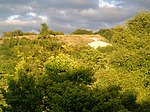Monks Risborough
Monks Risborough is a village and ecclesiastical parish in Buckinghamshire, England, lying between Princes Risborough and Great Kimble. The village lies at the foot of the northern scarp of the Chiltern Hills. It is 8 miles (13 km) south of the county town of Aylesbury and 9.5 miles (15.3 km) north of High Wycombe, on the A4010 road. Until 1934 Monks Risborough was also a separate civil parish, but it now forms part of the much enlarged civil parish of Princes Risborough, with the exception of Meadle and Owlswick, which are both now in the civil parish of Longwick-cum-Ilmer. The boundaries of the ecclesiastical parish of Monks Risborough are almost the same as the former Manor of Monks Risborough and of the original estate laid out in the 8th or 9th century. References to the 'parish' are therefore to the area covered by the ecclesiastical parish unless otherwise stated.The ecclesiastical parish of Monks Risborough includes the hamlets of Meadle, Owlswick, Askett, Cadsden and Whiteleaf.
Excerpt from the Wikipedia article Monks Risborough (License: CC BY-SA 3.0, Authors).Monks Risborough
Mill Lane,
Geographical coordinates (GPS) Address Website Nearby Places Show on map
Geographical coordinates (GPS)
| Latitude | Longitude |
|---|---|
| N 51.734462 ° | E -0.829831 ° |
Address
Cox Clifford Partnership
Mill Lane
HP27 9LG
England, United Kingdom
Open on Google Maps









